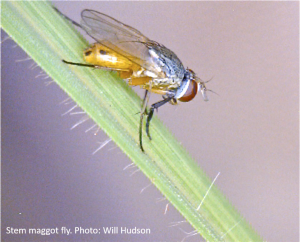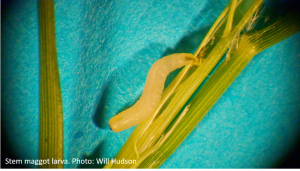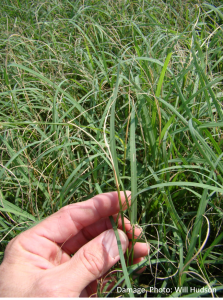Author: Dr. Will Hudson, Department of Entomology, University of Georgia
The invasive bermudagrass stem maggot (BSM), Atherigona reversura, has become a serious pest in GA hayfields since it appeared in 2010. The fly is native to Asia but is now found everywhere in the US where bermudagrass is found. The name stem maggot comes from the habits of the larva, or maggot, which enters the bermudagrass terminal by crawling down the terminal leaf until it reaches the node. There it macerates the pseudostem to release fluids on which it feeds. This kills the last 2 leaves and gives the grass the characteristic “frosted” look of brown tops on otherwise healthy plants. The damage is limited to those top 2 leaves, but causes the tiller to stop growing and forces the plant to break another tiller from a lower node. This slows or even stops growth of the hay crop and can reduce yields of certain susceptible varieties by over 85%. Common bermudagrass is preferred by the flies, but every cultivar of turf and forage bermudagrass tested so far has been attacked, even the super dwarf varieties used on golf greens.
The fact that the maggots are only found outwards of the terminal node limits the pest potential of the fly to bermudagrass grown for hay. The life cycle of the fly from egg to adult takes 3-4 weeks, with 2-3 weeks spent in the grass stem. In a pasture, cows will readily eat infested stems thereby eliminating the maggots and preventing populations from building up. The same effect is created in turf by mowing the grass. The maggots cannot survive in dry clippings, so if you mow more often than every 2 weeks the fly population will be controlled by the mower. If your mowing interval is longer than 2 weeks in bermudagrass, is it really turf?


